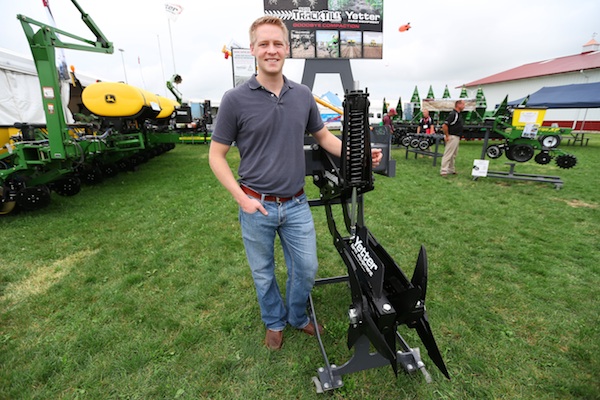
Tackling Production Problems with Technology
Colin Hurd noticed a problem. It was June of 2010 and he was working for Summit Farms in Alden, Iowa, as an intern following his freshman year at Iowa State.
“I was running a sprayer. I noticed the corn was yellower and shorter where the planter tires had been during planting,” says Hurd.
Soil compaction, which can be caused by large row planters, reduces air, nutrients and water to plant roots, restricting root development and ultimately yield.
Hurd (’13 agricultural studies) thought of those yellow leaves again that fall while participating in the Entrepreneurship in Agriculture course at Iowa State University. Students in the course were asked to develop an original business concept that solved a problem. Hurd’s idea was to attach a tillage implement behind planter tires that would break up soil compaction as they moved through fields.
“I thought if I could get a ballpark figure of how much yield is lost because of the planter weight, then I should be able to put together a spreadsheet and make a compelling business pitch,” says Hurd.
His in-class pitch presented to a panel of experts won him one of three scholarships to be used to further develop business concepts.
Over a period of two years, Hurd experimented with old tillage parts; worked with an engineer, Kyle Meyer (’05 agricultural studies), to create a design; established the corporation Agricultural Concepts; pursued marketing and distribution strategies; and had the final design tested through Iowa State University Extension and Outreach.
The research showed Hurd’s invention, TrackTill, increased yield in the center rows by eight bushels.
“That was a very important number,” says Hurd. “It meant the average farmer could look at TrackTill as an investment in yield and expect a payback within two years. That’s pretty significant.”
TrackTill was released in January 2014. By the spring of 2015, 60 people across the country, from Delaware to Kansas, were using TrackTill. Yetter Co. was interested in licensing it and had a national sales and distribution network. Hurd was certain they could get it to market a lot faster and could likely lower the price.
“The ultimate goal I always had for TrackTill was to make it acceptable and valuable to as many farms as possible and licensing it to Yetter was the best option for doing that,” says Hurd. He licensed it to Yetter Co. that spring.
By November 2015, Hurd had established his second business, called Smart Ag.
While working with TrackTill customers, he noticed how confined they were to short windows of time to plant and to harvest, and how difficult it is to find farm laborers during those windows.
“It was a real eye-opener for me,” says Hurd. “It led me to the conclusion that automation is the logical next step for farmers to improve their efficiency.”
Last fall, Smart Ag began in-field tests on new hardware and software that will allow a combine operator to have full control of an unmanned grain cart. The operator will be able to move the grain cart adjacent to the combine for loading, then to an unloading area and, later, a staging area.
“It can work on any brand of equipment or combination of brands. It’s a very simple plug and play style system that no one has developed or been able to bring to market,” says Hurd. “We are focused first on providing a simple, reliable system that will work well in a variety of situations. Then working with our first customers to add more features to optimize their grain cart’s performance based on a variety of variables and goals such as compaction control, multi-combine operations and preferred unloading and loading patterns in each field.”
The system’s online software will allow farmers to load in their field boundaries, navigate around unharvested crops or inner boundaries automatically, show a real-time map of the field on any internet connected device and receive notifications of obstacles or errors remotely. It will also have real-time obstacle avoidance built in.
Hurd says his Iowa State courses widened his perspective on agriculture and allowed him to find out what he enjoyed doing.
“I was really drawn to the business side of agriculture. And then the ag entrepreneur program broadened my perspective of what it means to work in business,” says Hurd. “People sometimes think that going into business means you’re going to go get a job with a major corporation and work your way up the ladder. But the entrepreneur program teaches you there are alternatives to that traditional path. You don’t have to have a road map all laid out for you; you can make your own road map based on your own ideas.”
Kevin Kimle is the director of the Agricultural Entrepreneurship Initiative and teaches the Entrepreneurship in Agriculture course. “Colin is fantastically creative and able to look at the future of agriculture and come up with very practical, but cutting edge innovations. He’s definitely a guy to keep an eye on,” says Kimle.
Hurd says he’ll continue to grow his business in Ames, Iowa. “At Smart Ag we’re always looking at ways we can use technology to solve problems on the farm.”



